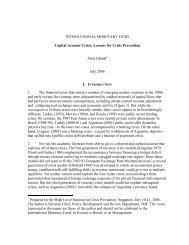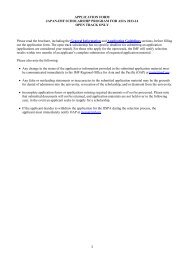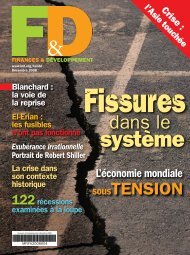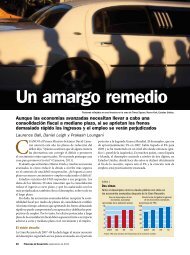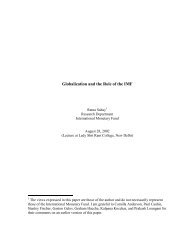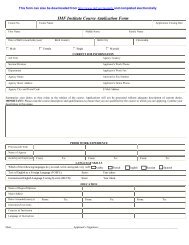Chapter 20: Taxation of Corporate Reorganizations - IMF
Chapter 20: Taxation of Corporate Reorganizations - IMF
Chapter 20: Taxation of Corporate Reorganizations - IMF
You also want an ePaper? Increase the reach of your titles
YUMPU automatically turns print PDFs into web optimized ePapers that Google loves.
Tax Law Design and Drafting (volume 2; International Monetary Fund: 1998; Victor Thuronyi, ed.)<br />
<strong>Chapter</strong> <strong>20</strong>, <strong>Taxation</strong> <strong>of</strong> <strong>Corporate</strong> <strong>Reorganizations</strong><br />
Generally, a merger will qualify as tax free in the United States if at least half <strong>of</strong> the net<br />
value <strong>of</strong> the transferor company is remunerated in shares <strong>of</strong> the acquiring company. 50 As far as<br />
the continuity <strong>of</strong> the business activities <strong>of</strong> the transferor company is concerned, case law permits<br />
nonoperating assets to be excluded from those transferred in the merger and leaves room for<br />
changes in business activity. 51 This approach leaves enough room to accommodate the demands<br />
<strong>of</strong> minority shareholders who ask for the redemption <strong>of</strong> their shares at the time <strong>of</strong> the merger.<br />
The requirements for other types <strong>of</strong> reorganizations in the U.S. Internal Revenue Code<br />
are more strict and mechanical. For example, in a type C reorganization, 52 the transfer <strong>of</strong> assets<br />
must cover "substantially all" assets, and at least 80 percent <strong>of</strong> the remuneration for the assets<br />
transferred, not taking into account the transfer <strong>of</strong> liabilities, must consist <strong>of</strong> voting shares <strong>of</strong> the<br />
acquiring company. Yet, these requirements for a tax-free merger leave room to shed some <strong>of</strong><br />
the useless assets and to buy out minority shareholders. 53<br />
An example <strong>of</strong> a far stricter application <strong>of</strong> the principle <strong>of</strong> continuity can be found in the<br />
European Union directive on the taxation <strong>of</strong> cross-border mergers. 54 In defining a merger, the<br />
directive refers to a "legal merger." This concept has been developed in the draft directive on<br />
cross-border mergers in company law. 55 The directive requires that all assets and liabilities,<br />
without exception, be transferred to the acquiring company. This requirement is <strong>of</strong> course<br />
closely linked to the idea that the acquiring company is the universal legal successor to the<br />
acquired company and therefore acquires title to all assets and liabilities <strong>of</strong> the latter without<br />
exception. This concept leaves little room for shedding some useless assets or for changing the<br />
conduct <strong>of</strong> business at the time <strong>of</strong> the merger.<br />
Similar restrictions apply to the continuity <strong>of</strong> the shareholder's interest. The part <strong>of</strong> the<br />
remuneration that can be paid in a form other than shares <strong>of</strong> the acquiring company is limited to<br />
10 percent <strong>of</strong> the nominal value <strong>of</strong> the capital increase that is necessary to compensate for the<br />
transfer <strong>of</strong> assets. 56 Since the fair market value <strong>of</strong> the shares is in most cases a multiple <strong>of</strong> their<br />
nominal value, only a small fraction <strong>of</strong> a few percentage points can typically be paid to the<br />
shareholders <strong>of</strong> the acquired company in a form other than the shares <strong>of</strong> the acquiring company.<br />
50 See Rev. Rul. 66-224, 1966-2 C.B. 114.<br />
51 Becker v. Commissioner, 221 F.2d. 252 (2d Cir. 1955); Bentsen v. Phinney, 199 F. Supp. 363 (S.D. Tex. 1961);<br />
Mary Archer Morris Trust, 42 T.C. 779 (1964).<br />
52 See supra note 48.<br />
53 See USA IRC § 368 (a)(1)(C).<br />
54 Merger <strong>Taxation</strong> Directive, supra note 6, art. 2.<br />
55 Commission <strong>of</strong> the European Communities, Proposal for a Tenth Directive <strong>of</strong> the Council based on Article<br />
54(3)(g) <strong>of</strong> the Treaty Concerning Cross-Border Mergers <strong>of</strong> Public Limited Companies, COM(84) 727 final (Jan. 8,<br />
1985).<br />
56 See Merger <strong>Taxation</strong> Directive, supra note 6, art. 2; see also FRA CGI Annex II § 301F. Nominal value is also<br />
known in company law as par value.<br />
- 16 -





